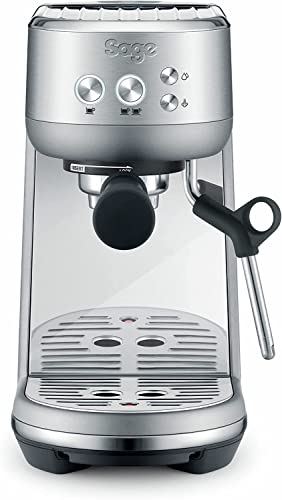Espresso Maker - A Must-Have For Home Baristas
Espresso is a dark, strong beverage that is made by forcing hot coffee through finely ground coffee grounds that are tightly packed. It is the base for many popular cafe drinks.
A barista, also known as an "espresso maker", controls many variables to make a fantastic cup. This includes the temperature of water as well as its pressure and how tightly packed the coffee is.
Origins
The espresso maker is a machine that pushes small amounts of close to boiling water under high pressure through finely ground coffee beans. The espresso is stronger than the other coffees and served in smaller cups. This is an excellent choice for those who want an incredibly strong cup of coffee but want it quickly!
In the 19th century the first espresso machines were invented. The coffee industry was huge in the 19th century, however, brewing took a lot of time. People were impatient and needed just a quick cup of tea!
Angelo Moriondo of Turin patented one of the first coffee machines in 1884. The machine's name was "New steam machinery, for the efficient and instantaneous preparation of coffee beverages. Method A." Moriondo."
The Milanese manufacturers Luigi Bezzerra and Desiderio Pavoni made improvements and adaptations to this machine. They incorporated the portafilter, multiple brewheads and other innovations that are still associated with espresso machines today. The machine was dubbed the Ideale and it impressed the crowds at the 1906 Milan Fair. Today Moka pots are used in Moka pot is found in nine out of the ten Italian households.
Variations
Espresso's flavor is more concentrated than coffee, which is why it is a great match with milk and other ingredients to make popular coffee drinks like cappuccinos and lattes. Its strong flavor is also evident in baked goods recipes and even marinades.
There are four primary kinds of espresso makers: manual lever, semi-automatic, automatic, and super-automatic machines. Each has a distinct method of creating pressure extracting the espresso.
A manual lever machine works with a piston that is mechanically operated to press water through grounds. It's the perfect blend of mechanical control and mechanized stability. You still have grind, tamp and pull the shot yourself but there's more control over the temperature and pressure.
Moka pots are a different manual espresso maker that functions like a modern pump-driven espresso machine. In an airtight tank boiling water, steam is created. This steam is transported into a basket containing ground coffee and through a metal filter into the top cup. They're less expensive than a full-sized espresso machine, but they can only reach up to 1-1.5 bars of pressure, which is lower than the ideal for brewing espresso.
Ingredients
Espresso makers can aid home baristas create cafe favorites like lattes and cappuccinos. You can add flavored extracts or syrups to espresso shots for an intense drink, such as an espresso martini.
To make a good cup of espresso you'll need top-quality beans, fresh milk and sugar. To ensure an even extraction, look for beans with a special espresso label. Grind them finely. You can experiment with different roasts until finding the one that matches your preferences.
You'll require a burr mill to grind the beans into a uniform texture. The espresso machine comes with a portafilter that holds the grounds and a tamper. This is used to pack the coffee in a tight manner.
You'll also require an espresso cup and a steamer or frother to make the silky aerated, aerated milk that's characteristic of espresso drinks. espresso machine with frother come with steam wands to make the process easier. It is also essential to remove the scale from the machine, which involves running an aqueous solution of vinegar and water through the system.
Techniques
Espresso brewing is based on the creation of pressure that allows for rapid extraction of intense flavors from finely ground dark-roast, dark-roast brewed coffee packed into a "puck." This method of brewing creates the strength of a coffee shot, also known as espresso. When espresso is properly brewed it will have a rich crema on top.
Contrary to the Moka Express that uses heat to purify water through coarsely ground coffee most espresso makers make use of highly pressurized water forced through small grounds under high heat. This results in an espresso-like drink that can be dilute in water or milk to make different drinks, like lattes or cappuccinos.

While the Moka Express is a simple, low-cost appliance, other espresso machines are complicated expensive, and come with numerous beverage options. The most well-known models, however, are Italian-designed lever machines which use spring-loaded arms to dispense hot water from a cylinder to a portafilter. The barista can alter variables like water temperature as well as grind size shot by shot to get the most optimal results. These machines were instrumental in bringing espresso to greater acclaim throughout Italy and Europe.
Equipment
A good espresso machine must be able extract soluble and non-soluble solids out of finely ground tightly packed coffee. This process is made simpler through the use of pressure and controlled variables such as temperature and grind size. Then there's the flavor that is influenced by a host of factors including the beans and the way they're handled and prepared.
There are a variety of espresso machines, however the semiautomatic is most commonly used. It utilizes an electric pump to agitate the water, and push it through the grounds. It also allows the user to do the grinding and tamping. These machines are the most affordable, however they aren't as consistent as a spring piston or other manual designs.
The lever models which are more expensive include the calibrated cylinder which does all the work. They're more tolerant than a spring piston machine however they still require some expertise to operate properly. These machines require a lot more maintenance. You will need to heat up the portafilter and take apart the piston and portafilter each time.
